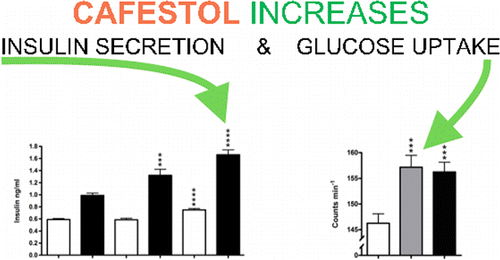Coffee compounds that could help prevent type 2 diabetes identified

Much to coffee lovers' delight, drinking three to four cups of coffee per day has been shown to decrease the risk of developing type 2 diabetes. Now, scientists report in ACS' Journal of Natural Products that they have identified two compounds that contribute to this health benefit. Researchers say that this knowledge could someday help them develop new medications to better prevent and treat the disease.
Patients with type 2 diabetes become resistant to insulin, a hormone that helps turn glucose from food into energy. To overcome this resistance, the pancreas makes more insulin, but eventually, it just can't make enough. High blood glucose levels can cause health problems, such as blindness and nerve damage. Several genetic and life style risk factors have been linked to the development of type 2 diabetes, but drinking coffee has been shown to help prevent its onset. Caffeine was thought to be responsible, but studies have shown it has only a short-term effect on glucose and insulin, and decaffeinated coffee has the same effect as the regular version of the drink. To investigate which of coffee's many bioactive components are responsible for diabetes prevention, Søren Gregersen and colleagues tested the effects of different coffee substances in rat cell lines.
The researchers investigated different coffee compounds' effects on cells in the lab. Cafestol and caffeic acid both increased insulin secretion when glucose was added. The team also found that cafestol increased glucose uptake in muscle cells, matching the levels of a currently prescribed antidiabetic drug. They say cafestol's dual benefits make it a good candidate for the prevention and treatment of type 2 diabetes. However, because coffee filters eliminate much of the cafestol in drip coffee, it is likely that other compounds also contribute to these health benefits.
More information: Fredrik Brustad Mellbye et al. Cafestol, a Bioactive Substance in Coffee, Stimulates Insulin Secretion and Increases Glucose Uptake in Muscle Cells: Studies in Vitro, Journal of Natural Products (2015). DOI: 10.1021/acs.jnatprod.5b00481
Abstract
Diet and exercise intervention can delay or prevent development of type-2-diabetes (T2D), and high habitual coffee consumption is associated with reduced risk of developing T2D. This study aimed to test whether selected bioactive substances in coffee acutely and/or chronically increase insulin secretion from β-cells and improve insulin sensitivity in skeletal muscle cells. Insulin secretion from INS-1E rat insulinoma cells was measured after acute (1-h) and long-term (72-h) incubation with bioactive substances from coffee. Additionally, we measured uptake of radioactive glucose in human skeletal muscle cells (SkMC) after incubation with cafestol. Cafestol at 10–8 and 10–6 M acutely increased insulin secretion by 12% (p < 0.05) and 16% (p < 0.001), respectively. Long-term exposure to 10–10 and 10–8 M cafestol increased insulin secretion by 34% (p < 0.001) and 68% (p < 0.001), respectively. Caffeic acid also increased insulin secretion acutely and chronically. Chlorogenic acid, trigonelline, oxokahweol, and secoisolariciresinol did not significantly alter insulin secretion acutely. Glucose uptake in SkMC was significantly enhanced by 8% (p < 0.001) in the presence of 10–8 M cafestol. This newly demonstrated dual action of cafestol suggests that cafestol may contribute to the preventive effects on T2D in coffee drinkers and be of therapeutic interest.
Journal information: Journal of Natural Products
Provided by American Chemical Society



















